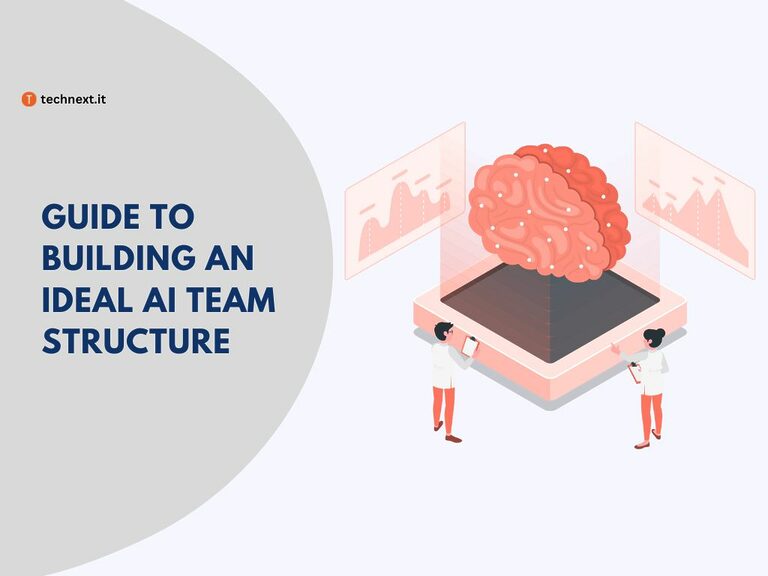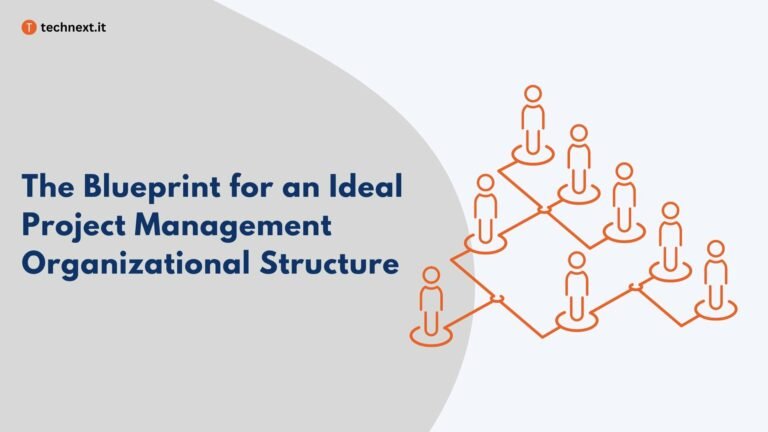A Simple Guide to Building the Ideal DevOps Team Structure
Learn the fundamentals of high performing DevOps team structure with this straightforward guide. The guide provides simple explanations of the different roles and responsibilities, as well as a helpful org chart that outlines the team structure.
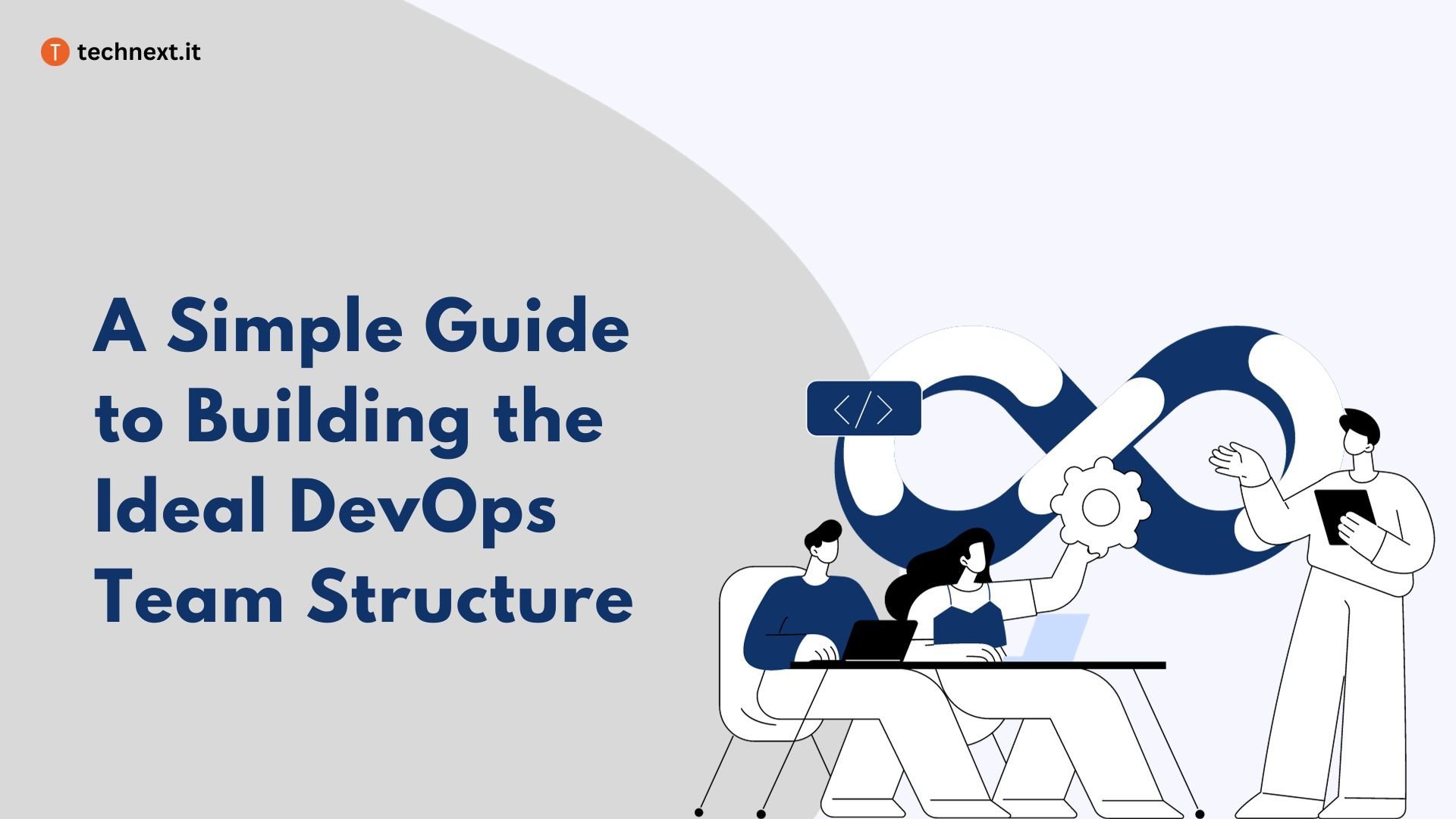
DevOps is probably one of the hottest buzzwords in the IT industry, and for good reason. It’s a software development approach that focuses on collaboration, communication, and automation between software developers and operations.
With the global DevOps industry expected to grow from $6.78 billion in 2020 to $57.90 billion by 2030 [1], it’s clear that more and more companies are recognizing the value of this approach.
But where do you even start with setting up a DevOps team? That’s where this simple guide comes in. In this post, we’ll walk you through the ideal DevOps team structure so you can start reaping the benefits of this powerful approach.
What is DevOps, and how it works?
As the name suggests, DevOps are the professionals who work together to bridge the gap between software development (Dev) and IT operations (Ops).
Although DevOps is a relatively modern approach to software development, it has quickly become the industry standard. But why?
Let me explain in simple terms: In a normal condition, you have a Dev team to write codes. And an Ops team that manages the server. Sometimes, the dev team writes code that works on their development environment but not the server; the ops team verifies that their server works fine. This is where your DevOps team comes to the rescue.
But how does DevOps manage the collaboration? They follow a continuous software development lifecycle (SDLC) and bridge the works of the development team and operations team. Let’s explain the SDLC with the following figure:
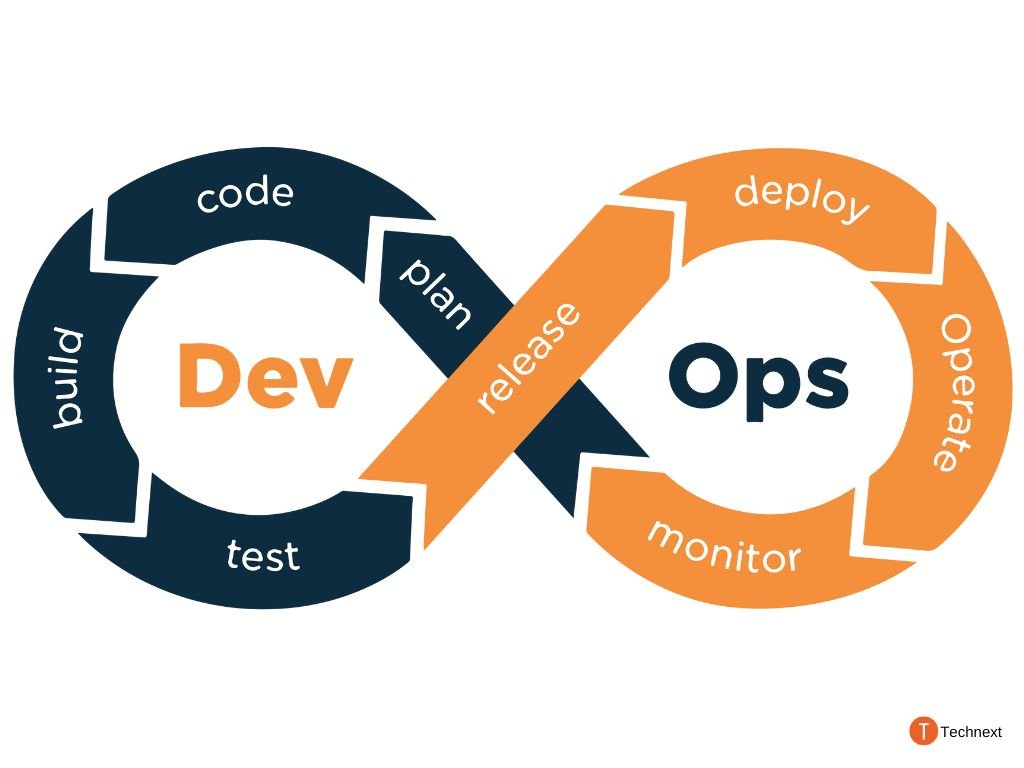
The figure illustrates how the DevOps team integrates development and operations in a continuous process with eight sequential stages, similar to the agile approach.
The project begins with planning, where they plan the entire development process. The second stage involves coding, and by the end of this stage, the developers push the code into version control.
Then, the build and test part comes into action. Together, it is known as Continuous Integration (CI). In this part, the DevOps team makes sure that the code is safe for deployment.
Moving forward, the release and deployment part is called Continuous Deployment (CD). Here, the DevOps team deploys the code to the server.
Lastly, in the monitor part, the application is being maintained and monitored. The monitoring leads to the feedback portion. That goes right back to the planning part again, and the cycle continues.
Responsibilities of a DevOps Team
Now, let’s discuss the responsibilities of a DevOps team. The roles may vary depending on the organization’s size, structure, and unique demands. However, here are some common responsibilities of a DevOps team:
- Dissolving organizational silos by collaboration between development and operations teams.
- Building, testing, and maintaining the continuous integration ((CI) and continuous deployment (CD) pipeline.
- Selecting the appropriate tools and technology for the team’s business needs.
- Maintaining software infrastructure as a code (IaC) to ensure consistency, reliability, and scalability.
- Designing cloud architecture by choosing the best cloud platform, service model, cloud resources, configurations, etc.
- Automating repetitive tasks to improve efficiency by implementing auto-scaling and self-healing mechanisms.
- Responding swiftly to issues as well as implementing preventive measures to avoid future occurrences.
Important Roles in a DevOps Team
It’s time to start thinking about the experts you’d like to have on your team. The roles of the DevOps team vary depending on the scope, complexity, cost, availability, and timeframe of the project. Here are some common roles in a DevOps team for your understanding.
DevOps Evangelist
- Responsible for ensuring the implementation of all DevOps processes.
- Ensure that both the development and operational teams are on board.
- Identify the key roles of the team.
Your DevOps Evangelist is the person who promotes and advocates DevOps culture and practices within your organization. He/ she works for removing silos and establishing a culture of collaboration by motivating and inspiring people across the organization. They not only promote the benefits of DevOps but also ensure all team members are trained.
Release Manager
- Manages the entire release lifecycle from scheduling to risk management.
- Maintain communication and collaboration.
- Monitor and measure the performance and quality.
The release manager is like the project manager of your DevOps team. He/She is the person responsible for managing the process of planning, testing, deploying, and monitoring software releases. Your release manager manages your team’s daily activities using Agile methods and the release management lifecycle.
DevOps Lead
- Designing and developing infrastructure and automation tools
- Implementing frameworks for continuous integration and continuous deployment
- Staying up-to-date on industry trends and best practices
DevOps lead is kind of like your go-to person in the team. He is responsible for developing scripts to automate infrastructure and software builds and training new team members in DevOps procedures and philosophy.
DevOps Engineer
- From designing to maintaining the CI/CD pipeline
- Monitoring all technical operations and providing on-call IT support.
- Collaboration with developers and operations staff
Your DevOps engineer is a general role that covers a wide range of tasks and skills related to DevOps. His/ Her responsibility includes designing, building, testing, and maintaining the continuous integration (CI) and continuous delivery (CD) process. They also work with developers to deploy and manage code and with operations staff to ensure systems run smoothly.
The Software Developer/Tester
- Writing and updating the code
- Involved in all stages of the product development process.
- Performs unit testing and deployment
You can call your Software Developer “the Craftsman” of your DevOps team. In a DevOps team, your developers not only write the code but also test it, deploy it, and keep an eye on it as it runs. He/ she is also responsible for updating the code, adding new features, and resolving bugs. Collaborating with the DevOps engineers is also his/her task.
Quality/Experience Assurance Specialist (QA/XA)
- Setting the project’s quality and user experience
- Performing routine inspections and quality tests
- Identifying and reporting any defects, errors, bugs, or glitches
The person in charge of ensuring the products and services’ quality is your Quality/Experience Assurance Specialist (QA/XA). They work alongside your software developer and DevOps engineers to ensure product quality. His or her responsibility includes developing quality assurance policies and processes, running tests according to the standard, and writing the automated test.
Security and Compliance Engineer
- Oversees DevOps security.
- Integrating security measures into the CI/CD
- Responding to security breaches
Your Security and Compliance Engineer ensures DevOps and software product security and compliance.
He/She collaborates with the software developers and the DevOps engineers to implement secure practices and standards, as well as to monitor and manage risks and threats. Your SCE also monitors malicious behavior, responds to security breaches, and does root cause analysis.
How to Build a DevOps Team with an Ideal Structure
Ready to build your DevOps Team? First, let’s discuss some of the most essential aspects of building one, such as the size of your team, the primary roles, the structure, etc.
Understand DevOps Principles
Before you start building a team, make sure you and your organization have a solid understanding of DevOps principles.
If your team doesn’t have someone like this, consider hiring someone or a fractional CTO who understands collaboration, automation, and shared responsibility for software delivery.
Assess Current State
Assess your current development and operations teams to identify strengths, weaknesses, and gaps in skills and processes. Understand where DevOps practices can be most beneficial.
Also, find out the scale of responsibilities you want your DevOps team to handle.
Determine the Size of Your DevOps Team.
In order to get your DevOps team up and running, you must first determine how many team members you need to hire. There is no one-size-fits-all answer to this question. It always depends on factors like the project’s complexity, timeline, and budget.
Experts suggest the best Developer-DevOps ratio is somewhere between 3:1 to 5:1. Other experts suggest a ratio of 10:1 to 12:1. The fact is the size varies according to the need of your project or organization. For example, Google has a ratio of 6:1.
In general, an early-stage team has between five to ten people on the DevOps team.
Structure Your DevOps Team
Once you have figured out the necessary roles and team size of your DevOps team, your task is to structure them for optimal outcomes.
Say yours is a startup. Commonly, for early startups, a few engineers do DevOps responsibilities themselves. This is called the embedded DevOps team.
As for mid-level and large companies, a DevOps team is beneficial so you can see a nested DevOps team hierarchy known as a Stand-alone team. They mostly followed the Flat organizational structure or Matrix organizational structure, depending on different variables.
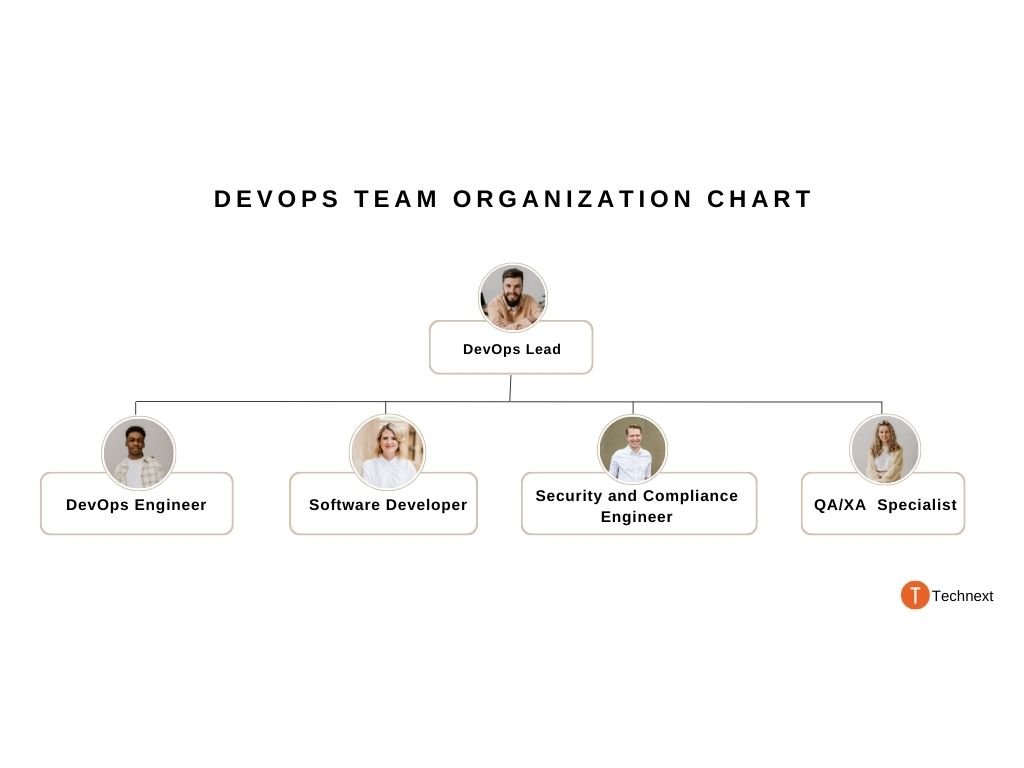
As you can see from the diagram above, in a flat structure, the DevOps lead oversee the team of DevOps Engineer Software Developer/Tester, Security and Compliance Engineer, and Quality/Experience Assurance Specialist (QA/XA),
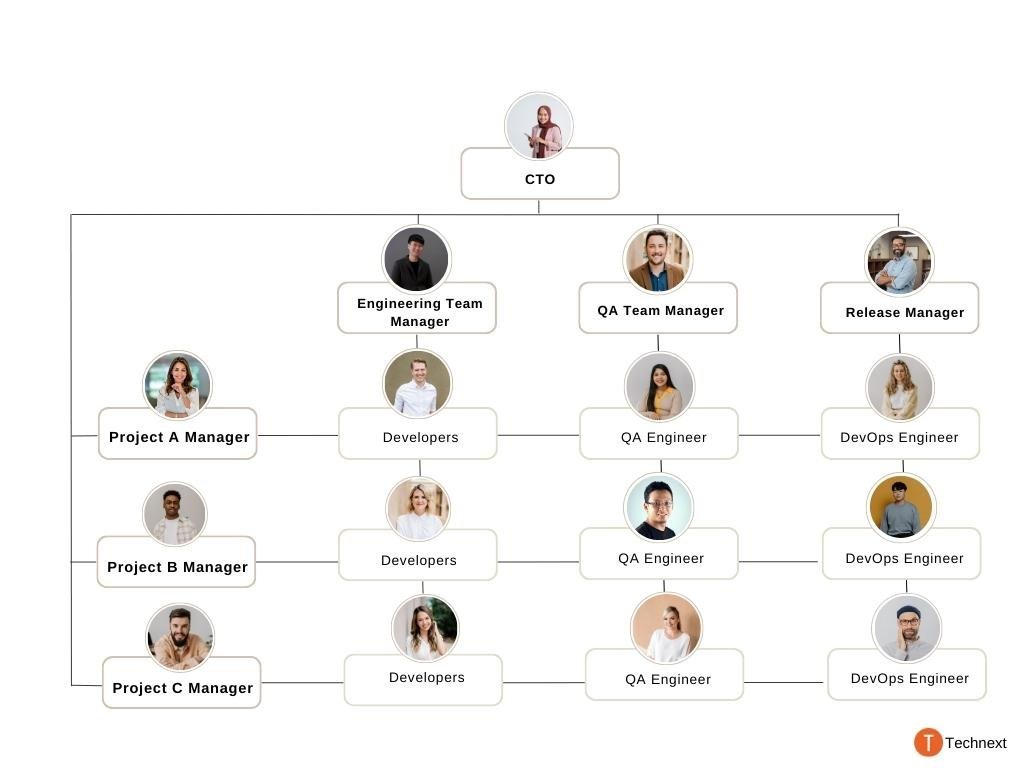
When any member of your DevOps team collaborates with the dev or ops team, they usually follow a matrix team structure. In such a combined team, both the project manager and DevOps lead determine the responsibilities of an engineer.
That doesn’t mean that matrix team structure is your only option. You can follow a projected or composite team structure as well. Ultimately, it depends on the approach your organization is taking.
Talking about approaches, you actually have several options available, such as the SRE approach, DevOps crowd ownership, outsourced DevOps, etc. In the end, team approaches and structure depends on your organization’s requirements.
Best Practices for Building a DevOps Team Structure
Now that we’ve laid the foundation, let’s move on to DevOps best practices. For faster and better product delivery, it is very important to follow these best practices from the beginning.
- Adopting Continuous Integration and Delivery (CI/CD) will enable faster, safer, and more reliable delivery of software products.
- Choosing the right tools for each phase of the DevOps lifecycle will increase software quality and speed of delivery.
- A Cross-functional team structure is very effective for a DevOps team.
- Setting up automated testing will ensure the quality and security of software products.
- Embracing Infrastructure as Code (IaC) and pushing for a Self-Service Infra Model increase productivity and speed.
- Avoiding manual work will reduce errors and increase efficiency.
- Continuous feedback will ensure that each team member has all the information needed to do their jobs on time.



